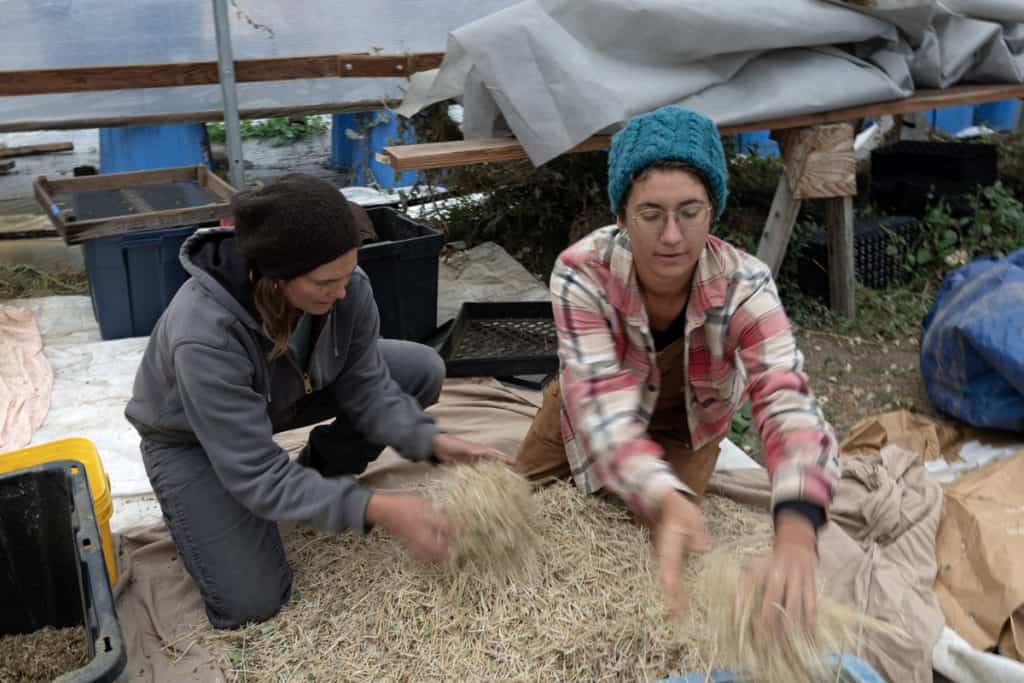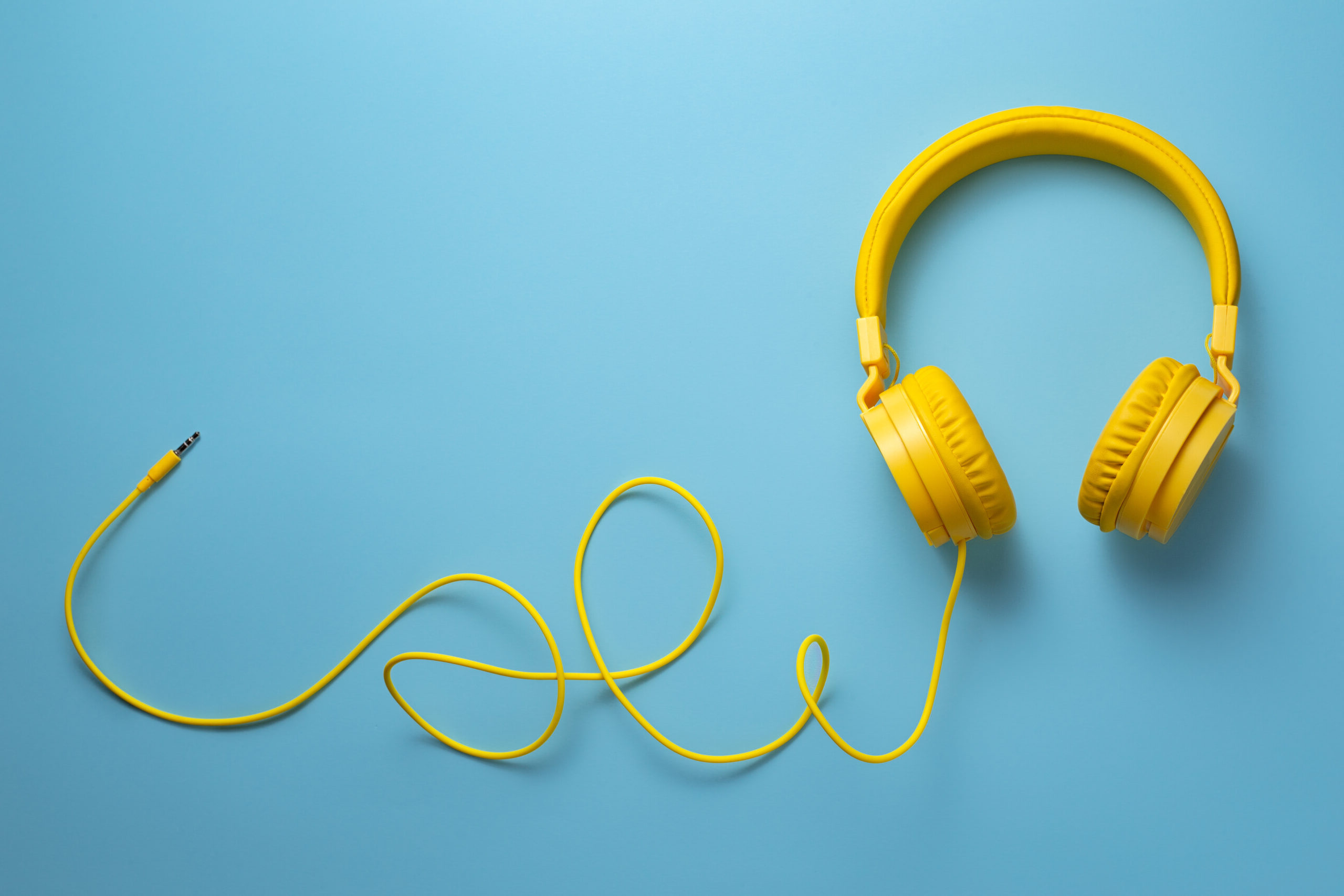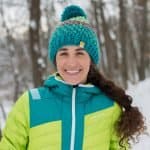The world is becoming hotter and drier. Farmers are starting to gather seeds that are okay with that.
Growing Seeds That Can Thrive in Tomorrow’s Climate
Laura Parker’s boots are thick with mud as she moves slowly down the row of sorghum on her farm, High Desert Seed, in the Upper Uncompahgre Valley of southwest Colorado. Hidden on each stalk, beneath a spray of dried flowers, are seeds that can be eaten or saved for planting.
“I’m using natural systems [to adapt seed varieties], and I want my seeds to be resilient in those systems,” Parker says. “A lot of the seed available right now has been grown in the most gentle climates in the country; what I am doing is making hardy seeds.”
Parker carefully clips each stalk at knee level and hands armfuls to Mae Turner, one of her four employees, who will transport it to a greenhouse where the seeds will be separated from the chaff.
Since 2015, the 35-year-old Parker has been producing open-pollinated seeds on roughly 4.5 acres near the town of Montrose, which — along with the entire Western Slope of Colorado — is experiencing a historic drought.
While thirsty crops like alfalfa and corn dominate the region, Parker has emerged as a leader in revitalizing a wide variety of crops that grow well in arid ecosystems. She uses real-time growing conditions to develop drought-hardy vegetable, grain and legume varieties that farmers across the Southwest can grow in the conditions created by the changing climate. Currently, she has 133 varieties of vegetables and grains available, with about 50 more in development.
Farmer Mark Waltermire, owner of Thistle Whistle Farm in Hotchkiss, Colorado, sources many of the seed varieties he grows for his community supported agriculture (CSA) program from High Desert Seed. And he has seen the value of this local breeding first-hand. “Having someone who is willing to adapt seeds to our climate allows me to be better at growing food for my community,” says Waltermire.
Breeding for drought tolerance
Growing up in a ranching family near the town of Rifle, Colorado, Parker has spent her life surrounded by farmers and ranchers who have had to be responsive to ecosystem pressures. Before beginning her own farm, Parker worked on many levels of the food system and seed landscape, which gave her the perspective to understand where she could drive positive change and empower small farmers to remain productive in dry environments.

The region’s arid climate means that crops benefit from abundant sun and low pest and disease pressure. But it also means water is a constant concern, not only for crop yields, but also for downstream communities relying on the Colorado River.
“That’s our water,” Parker says, pointing to the mountains that rise behind her farm. High Desert Seed takes its water from the Uncompahgre River, a tributary to the Gunnison River, which itself flows into the Colorado. Approximately 80 percent of all Colorado water comes from snowmelt, and Parker can keep track of the snowpack and predict drought years with her own eyes.
“There are years where it’s looking bad, then we get saved by a huge snowstorm,” Parker says. “But most of the time we know by February what kind of year we’re heading into.”
While snowfall was in the average range this year, a hot spring created early melting conditions. The general trend of lower snowpack continues to be a concern for farmers and others in both the Upper and Lower Colorado River Basin.
Though Parker flood-irrigates her production fields, she strategically stretches the time between waterings to look for plants that are more drought tolerant than others. Then she saves their seeds.
“With some of the crops, I’ll try to irrigate every 15 days, which is really stretching the level of what they can handle,” Parker says. “There are different benefits in intentionally restricting water. In certain crops, I’m seeing a different root morphology, and that’s one of the things that I’m most excited about.”
Parker explains that a big piece of developing drought tolerance is breeding and selecting for plants with stronger taproots that can dig deep into the soil to find water. Plants with a taproot tend to do better in drier soil conditions, creating more resilience and self-sufficiency.
Getting past Big Ag
While the global seed industry continues to develop novel disease- and drought-resistant varieties, much of the seed available to farmers isn’t produced for microclimate-specific challenges. The uniformity of the global seed industry also leads to the development of products that specifically fit into the distribution mechanisms used to move products around the globe.

“There’s not a lot of flexibility for farmers to be able to grow crops that can’t be mechanically harvested or have a shorter shelf life,” says Emily Rose Haga, executive director of Seed Savers Exchange, the nation’s largest nongovernmental seedbank dedicated to preserving and sharing heirloom varieties.
Haga notes that pursuing nuanced crop adaptations for specific growing conditions — such as limited rainfall — is increasingly important for small, independent seed producers like Parker, who may not have the infrastructure or corporate investment that large seed companies do.
“Small producers have the option to look for varieties that may not be the focus of the global seed trade,” she says. “They might need varieties that are more cold tolerant or more drought tolerant. Small producers also have the flexibility to grow a wider diversity of crops and varieties than what is mass-produced and popular.”
This flexibility gives Parker the freedom to trial less common varieties like tepary beans, which are native to the Southwest and Mexico, and were cultivated by Indigenous agrarian communities for millennia before the advent of irrigated row crops.
“We do get a monsoon period most years in July; this July we were trying to get our tepary beans to go to seed from one big rainstorm,” Parker said earlier this fall. “They have started to set, and I don’t think they’re going to make it before the frost. But I’m excited to keep pursuing that bean next year.”
Working to reintroduce varieties that have evolved in arid climates is part of Parker’s approach to working with — rather than against — her region’s often-harsh growing conditions. Leading with the intricate relationship between weather patterns and crop needs has led her to intervene as little as possible. “Conventional breeding is trying to bend nature to what they want, but what we are doing is looking for and pulling out the qualities the plant might already have,” Parker says.
As with many seed producers, Covid was a growth springboard and created a surge in High Desert Seeds’ sales, which are split about half between her web-shop and retail partners in the region.
Considering the downstream water supply
With the flow of the Colorado River down 19 percent from the 1900s, low water-input agriculture isn’t just a move toward food security in low precipitation years; it is a measure that must be taken to continue supplying water to the 40 million people who rely on the Colorado River.

Western Colorado communities act as the gatekeepers for water that is vital to agriculture and urban growth in the Lower Colorado River basin states, including Arizona, California, Nevada, Utah and New Mexico, says Colorado state Representative Marc Catlin (R-Montrose). He grew up farming in Colorado and serves on the board of directors of the Colorado River District, a water planning and policy agency.
“We are all trying to prepare ourselves for what the weather is going to do,” Catlin says. “We’re like everyone else in agriculture; we’re worried more about next year than this year.”
Agriculture is the economic backbone of west-of-the-Rockies Colorado and one of the top industries in the state, contributing $47 billion annually. Farms that source water from Colorado River tributaries, such as High Desert Seed, can be instrumental in helping adapt the region to the new reality, even though they are upstream from the true crisis.
“If Colorado is serious about the water game, we need to start financing projects that conserve water,” Catlin says. “Because water left in the river means that we don’t have to suffer as much of a shutoff when a shortage comes.”
There are more than 575 miles of canals and laterals in the Uncompahgre Valley, most of which have dirt bottoms, meaning more than 20 percent of the water flow is lost to seepage. “We can develop irrigation systems that use substantially less water. A concrete, lined canal loses much less water than an earthen canal,” Catlin says.
Protecting biodiversity
Waltermire of Thistle Whistle Farm appreciates the diversity of the seeds that Parker is producing. The farm, which sits at 5,330 feet, just below the elevation of High Desert Seeds, sees intense sunlight, as well as low perception and low humidity.

“It’s so important to have a seed source like Laura’s that helps adapt varieties that we need to hold on to, because they are distinctly better for many reasons,” he says. “We get high-flavored foods coming out of these conditions — the stress creates flavors that are distinctly different and better.” He adds, “Laura believes in the same things that I do: stories, flavor, and resilience.”
Keeping seed diversity available to small growers is a supply chain imperative, says Haga of Seed Savers Exchange. “Independent seed producers have the ability to steward a wider selection of crops and varieties that don’t necessarily have [the] traits [that the global seed trade breeds for like uniformity and shelf life], and that’s really important for regional and local food security.”
As Parker and Turner thresh this year’s seed stock in the farm greenhouse by hand with a winnower, it starts raining. While the drops patter on the plastic structure, Parker talks about how preserving seed biodiversity will take a global grassroots effort. According to the FAO, the global food supply relies on roughly 200 plant varieties. Without preserving heirloom varieties, the nutritional quality and flavor of food will suffer, a fate she says we are already experiencing.
“Most people don’t realize how much climate change will influence the way our food tastes as farmers lose access to a diversity of seeds and agricultural knowledge,” Parker says. “In the small-scale seed realm, farmers really support one another, [and] in the face of climate change, we need that collaboration.”
This story originally appeared in Civil Eats. It is part of the SoJo Exchange from the Solutions Journalism Network, a nonprofit organization dedicated to rigorous reporting about responses to social problems.
Weighed down by negative news?
Our smart, bright, weekly newsletter is the uplift you’ve been looking for.









